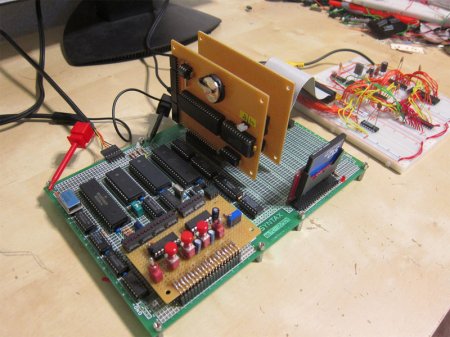
[Matt Sarnoff] is designing his own 8-bit computer from scratch. This means not only designing the hardware but also writing his own kernel and custom libraries. Since we last saw this 8-bit machine hes added both video and sound output which has allowed him to start developing some software for his computer (see it play Conways game of life after the break).
Sticking with the retro theme of his computer he uses a TMS9918 chip to output the video and a YM2149 for audio. The YM2149 was the audio chip used in the Atari ST allowing him to play songs generated for that system with a little bit of hacking to account for the fact that the Atari ST ran at 8MHz where his Motorola 6809 only runs at 2MHz.
Via [Retro Thing]
[youtube=http://www.youtube.com/watch?v=xwScZU9qwbk&w=470]
[youtube=http://www.youtube.com/watch?v=3TLg3MAHWCg&w=470]
















Wow, pretty amazing. Can’t imagine how long that would take to design and complete.
6809 all software developers should be REQUIRED to learn programming on that.
Why the UNI’s are dumb and do not force programming students to start with assembler and dealing with small processors FIRST blows my mind. it’s why we have a large number of brain dead CS degrees that cant program their way out of a paper bag.
http://drc.ohiolink.edu/handle/2374.OX/15230
for a design using 5 of the processors together for multiprocessor goodness.
@fartface
I agree 100%. I learned on that microprocessor many many years ago, and it made me a much better programmer. Its a great place to start!
BTW: That is one nice project up there!
@fartface
I agree totaly too!
Started on pics using assembler, then did c, c++ at uni ( electronics degree) and Now im doing c# with websites and ce devices – better programmer because of it.
That’s not a hack! It’s purpose built, has no duct tape and no Arduino!
/joke
Awesome project some day I may actually have time to do something like that
Another good chip that isn’t looked at often is the MC908 from freescale. It is sold in dip format so easy to breadboard, comes with a bootloader installed , only need a serial port/usb port and crystal to start using it. They are also cheaper than most of the other options, about $3 for one that does usb.
Freescale is also good about free samples.
I agree! Learn Assembly first. It instilled writing tight efficient code.
I loved the 6809 CPU. Did a ton of products on it for the RS Color Computer. Wish the Coco had used the TI chip instead of the 6847 video chip.
I think Hatachi had a faster version of the 6809. Dont remember the speed but much faster than the stock 2MHZ Motorola version.
Wish the guy the best on this project!
wow i started a project like this but sadly never finished >:
Very, very cool project. Takes me back to learning 6502 ASM and being drilled on fetch/execute cycles.
@Nightstar: Hitachi 63C09, 3.5MHz
http://en.wikipedia.org/wiki/Hitachi_6309
6809 was the nicest, most orthogonal 8-bitter there was. Strange that Motorola decided to develop the 16-bitter-but-with-an-8-bit bus 68008 at the same time. This chip also had a nice instruction set for hackers so the 6809 was pretty marginalised even back when it came out. (I happened to learn 68k assembly at uni on VME machines.)
I think Motorola wanted to have a set of instruction that had as little exception as possible. The old 8088 was the worse ofender of this and the 68K was the best. But still have a warm spot for the 6809 and e variant.
I agree with fartface, and will add GREAT PROJECT!
Im dizzy from shaky video!
How would one get started with programming their own kernel?
This is where I started – On a CoCo.
Get it to run OS-9 that would be cool!
I agree learning this way make better programmers.
I know programmers who haven’t got a clue as to what goes on under the hood. And don’t want to know because they don’t feel its important.
To paraphrase Carl Sagan:
If you wish to make an 8-bit computer from scratch, you must first invent the universe.
I’d best hurry up and finish my TTL processor!
i also agree fartface
actually i just wanted to type out fartface
Anyone knows some video chip like TMS9918 but more available?
I really like the music the Game of Life generates.
I recall an interview with some senior intel engineers where they were commenting about the lack of people in the field that knew how to create and program processors and what was really going on behind the scenes. I think people are too quick to overlook some of the more basic circuits and are always looking for a dedicated chip with the functions they want. That is great as long as their are chips that have the functions you want, but what do those same people do when those premade circuits aren’t sold ?
We did a whole bunch of assembler stuff at uni.
I’m still a “brain dead CS degree” though :(
I freakin’ love those YM2149s.
@Derwin: thanks for pointing that out, I had my speakers off the first time I watched it.
I agree, the 6809 running OS-9 was a great combination. I wored awhile with a 8080 S-100 bus that was in Kilobaud (?) magazine. The 6809 as was easier then the 8080.